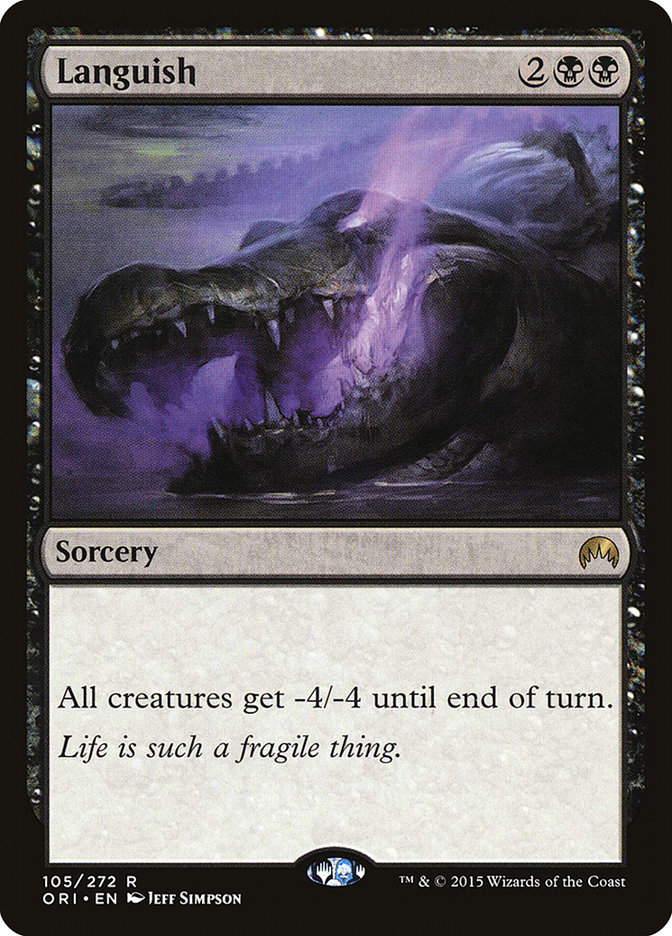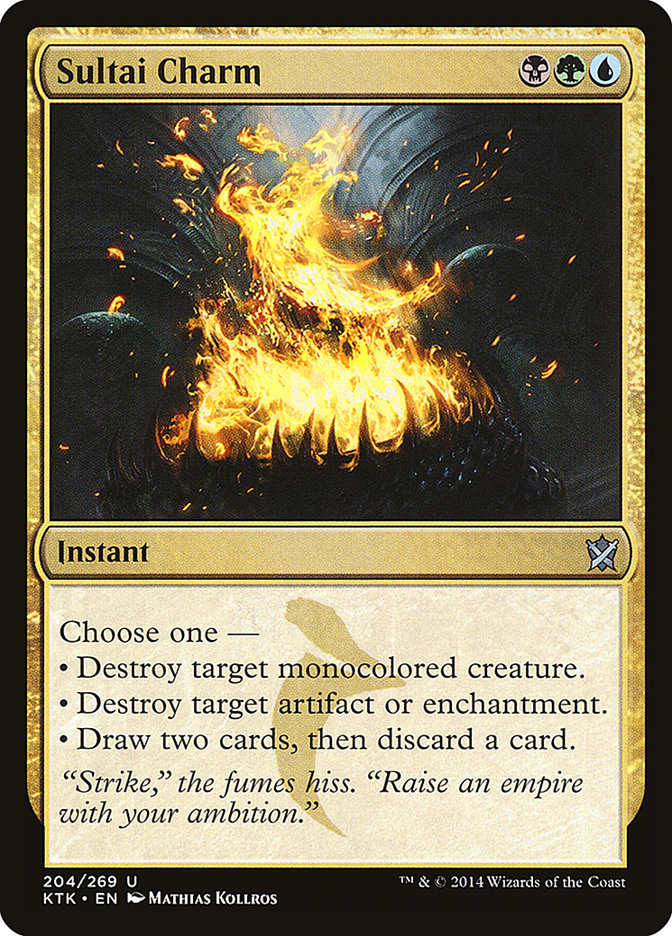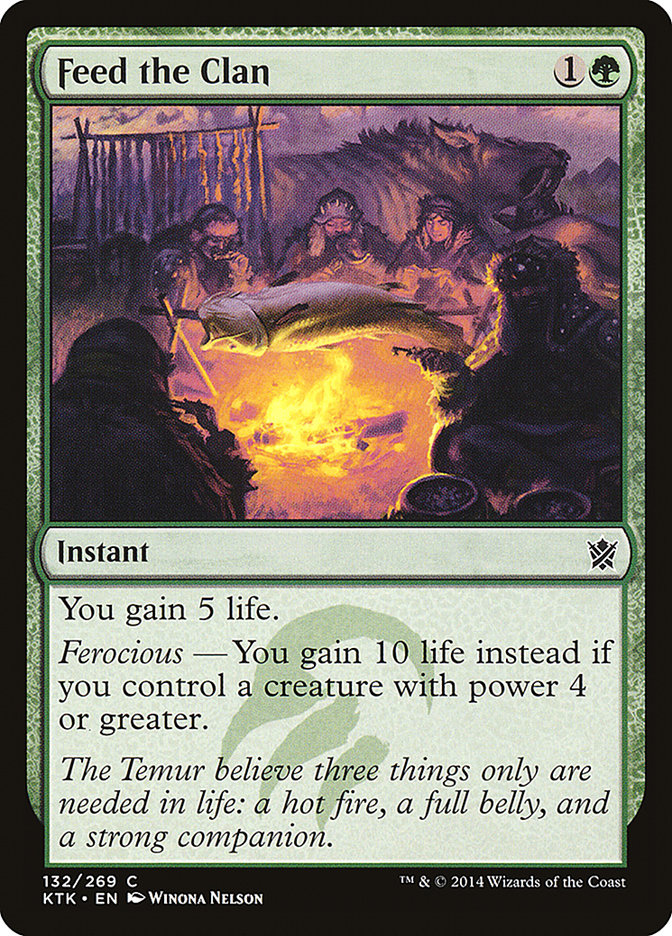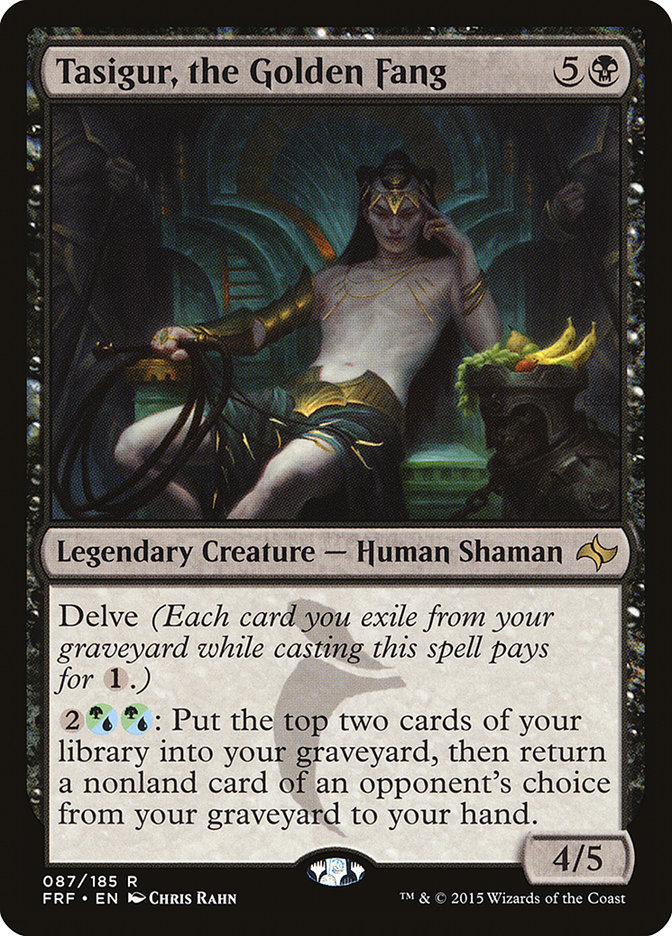I am rejuvenated!
The boss gave me a week off after my attempt at one-handed typing failed miserably. For those of you that have seen me these last few weeks, you may have noticed that I had a brace on my right hand. My teaching job can be full of peril at times, and I had a bad experience with a door with the end result being a broken hand. I’m relatively healed now and ready to provide you all with the control content that I am passionate about right in the nick of time!
Magic Origins is upon us next week and with the new set comes a frewsh opportunity for control to regain its rightful position at the top of the tiered archetypes. A very brief history lesson will give you all the same excitement that I’m experiencing at this very moment. When Khans of Tarkir was released, I boasted of the power of control and narrowly lost in the finals of the first Standard Open that the set was legal in. After Dragons of Tarkir was spoiled, I crafted a powerful Esper Dragons list that gave me a Top Sixteen finish at the Season One Invitational, as well as adopted and moderately altered at Pro Tour Dragons of Tarkir the next week. It is time for Magic Origins to provide you and I with results in the Standard tournaments to follow, specifically the Richmond Open at the end of this month.
Control is at its strongest point immediately after any new set is released regardless of the amount of new cards added to the list. This is because removing creatures, creating card advantage, and playing powerful win conditions are all part of a winning formula against everyone else in the room who’s trying new strategies out. We as control players take advantage of inexperience and ingenuity, which feels fantastic. It is almost as if we set the bar for success and create the golden rule question of any new format, which is “can you beat board wipes and card draw?” If the answer is no, then they are in a world of hurt when paired against a Soorani strategy. The list I’m focusing on today is an ode to Gerard Fabiano and his Sultai religion. Many people link him to Sultai much as they link me to Esper. He and I can, and do, play different decks, but those are our trademarks.
His recent article has a take on Sultai that is very similar to the one that I’ve been running for about two weeks straight on Magic Online. The glorious advantage to teaching is having the entire summer off, and with that free time I’ve been grinding MTGO until the wee hours of the morning. This much testing has led me to a crisp, polished Sultai list that I’ve been dominating with in the current Standard. Gerard and I have always been champions of control; therefor it’s no accident or surprise that our lists are very similar. I’m going to discuss the ins and outs of Sultai and the new Magic Origins card that will make it a force to be reckoned with.
Creatures (7)
Planeswalkers (5)
- 2 Ashiok, Nightmare Weaver
- 1 Kiora, the Crashing Wave
- 1 Garruk, Apex Predator
- 1 Ugin, the Spirit Dragon
Lands (24)
Spells (24)

Our Sweeper Has Returned
Do you hear the celebration by the masses? I sure do. There are the usual naysayers that say -4/-4 is simply not enough destruction. These people say that Siege Rhino and Tasigur, the Golden Fang live. My response is to get used to it. There won’t be a Wrath of God reprint in the foreseeable future, and I am tempted to hop onto the next flight to Seattle and personally thank R&D for the bone they tossed us. In a world where the best counterspell that has no strings attached is Dissolve and the best removal spell costs three, we are lucky to receive a sweeper that is finally good enough versus aggressive decks. Do you know how ridiculous it is each time we are forced to sideboard out board sweepers against Mono Red? That day is finally done.
Languish is the sweeper for the future, and it does the job we need it to do. Siege Rhino is not a card that beats control decks. It’s a fantastic creature that is abusive toward all non-control strategies, but against us it simply a creature that has a Lightning Bolt attached. The creatures that come before it and after are much more devastating, and rarely do we lose to the Modern-playable rhino. If our opponent plays a Fleecemane Lion and then an Anafenza, the Foremost, we simply have to leave mana up when on the draw and use one of our million removal spells or counters to deal with a five-toughness creature. Languish is the card that will even the playing field against all the midrange and aggressive decks because it kills every living creature that control fears. All of the mana accelerants, the monstrously indestructible Lions, Stormbreath Dragons, Dragonlord Ojutais, Atarka Red armies, Deathmist Raptors, and the list could go on for days. The list of creatures that dodge the Languish slaughter is significantly smaller and irrelevant. We are starting off the list with three copies in the maindeck and one in the sideboard, but I can easily see all four finding their way on the starting team. I cut one copy of Bile Blight, Perilous Vault, and Crux of Fate to make room in this build of Sultai. Crux of Fate is still a great card for Dragon control decks, but here it’s ineffective. When I take a look at Esper Dragons in the future I’m going to have a hard time splitting the mass removal between the two, but for those of you Dragon fans I’d main deck Languish and board Crux of Fate at this point in time.
Languish allows for creatures with five toughness to be included in the deck with ease. I really want to play Tasigur, the Golden Fang in the maindeck, however, I have enjoyed keeping my maindecks with zero targets for removal until it’s too late. Tasigur, the Golden Fang was usually sideboarded in when I didn’t need Crux of Fate, but now I’d bring it in against all matchups. Being able to Languish and then pay one for a 4/5 is absurdly powerful for a control deck which is used to sweeping and then just ending the turn. Silumgar, the Drifting Death might be a solid addition for control in Magic Origins Standard, giving Languish an even-bigger boost if need be against those midrange opponents and their pesky Rhinos. I’ll be sideboarding in the singleton Dragon against all decks besides control now that fewer Vaults and big sweepers are present overall. The fact that Languish doesn’t kill five-toughness creatures will be more beneficial to us than detrimental. We can sculpt our control deck in a fashion that will punish opponents and leave behind our win conditions as the dust settles. Pick up your set of Languishes and get ready to take back the stage from those mana producers and Raptors that have plagued us these last few months.
Why Sultai?
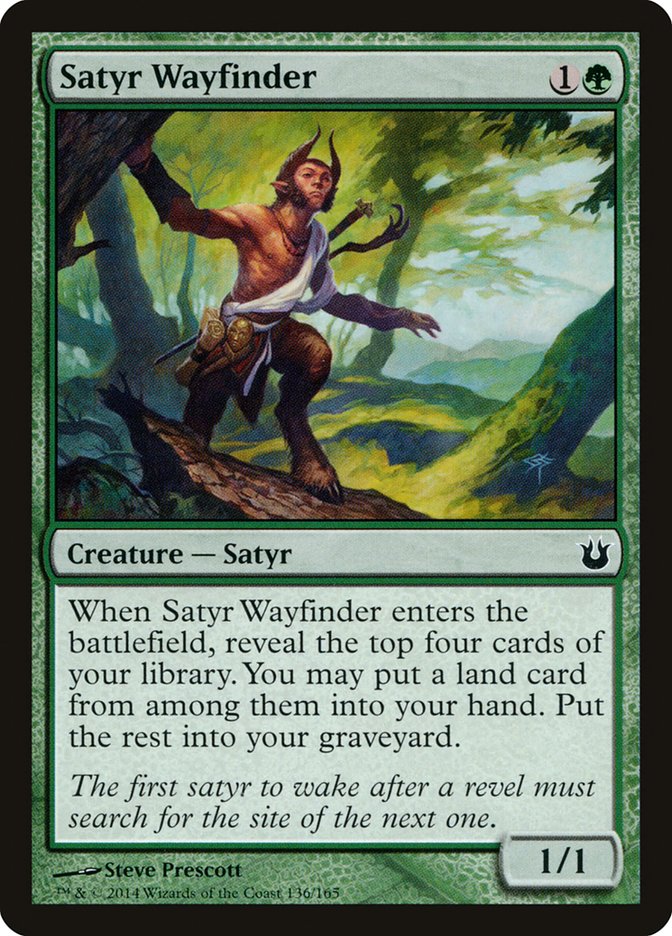 Many of you remember when I was starting off the new Khans of Tarkir Standard with Sultai Control during the spoiler era. I was sold on the power of the green engine of Sylvan Caryatid and Courser of Kruphix, however I was not aware of how easily Delve can be abused by control when equipped with Satyr Wayfinder. Satyr Wayfinder in a control deck is actually Dark Ritual, and it allows us to Dig Through Time faster than R&D ever intended. Den Protector is likewise added to the list of cards that control can abuse more than the other archetypes – getting back Ugin, the Spirit Dragon or Dig Through Time is much more devastating than the usual targets of Thoughtseize or Siege Rhino, good though those may be.
Many of you remember when I was starting off the new Khans of Tarkir Standard with Sultai Control during the spoiler era. I was sold on the power of the green engine of Sylvan Caryatid and Courser of Kruphix, however I was not aware of how easily Delve can be abused by control when equipped with Satyr Wayfinder. Satyr Wayfinder in a control deck is actually Dark Ritual, and it allows us to Dig Through Time faster than R&D ever intended. Den Protector is likewise added to the list of cards that control can abuse more than the other archetypes – getting back Ugin, the Spirit Dragon or Dig Through Time is much more devastating than the usual targets of Thoughtseize or Siege Rhino, good though those may be.
Spells in a control deck are inherently more powerful than those in aggressive or midrange strategies because we are paying a higher premium in terms of mana cost. Our eight-mana spell will wreak far more havoc than a three-mana one from our Abzan Midrange friends. That being said, Sultai answers opposing threats early while filling the graveyard up and then follows up with Den Protectors that buy back any of the spells we’ve used in battle or buried by our Satyr friend in the early turns. You all know that I’m the farthest thing from a green mage there is, but with spells like these I can’t resist. With 24 lands and four Satyr Wayfinders, hitting land drops is close to automatic. There are times where we miss on our Satyr Wayfinders, however it’s rare enough that it’s worth the risk. A high chance of making each land drop is enough to pique my interest, and the synergistic bonus of filling our graveyard for our powerful Delve spells is the icing on the cake for this Esper mage.
We have a shard land in Sultai! Esper fell short for me after a few nice finishes due to the mana limitations. You can have the same color success with Esper when comparing it to other shards, however without a land that produces all three colors, the deck has to play more lands that enter the battlefield tapped in order to compensate. This deck has one less land that enters the battlefield tapped, however Satyr Wayfinder allows us to pick an untapped land more often than not. If I were to play Esper Control again it would have to have a maximum of ten tapped lands and a minimum of sixteen untapped lands for me to consider it. The format is too fast and now that we have a four-mana sweeper, that land on turn four must enter the battlefield untapped if we are to ensure victory. Opulent Palace and Satyr Wayfinder make casting our spells easier and timelier. Combine that with the exciting cards that only Sultai can use and you make a powerful control contender.
The most exciting card from the Sultai shard is easily Sultai Charm for me. When it was released I was immediately in love due to the three modes that the Charm contains. The Achilles Heel of control is typically a resolved enchantment or artifact, but with this Charm there is no need to worry. Plagued by a pesky Outpost Siege or a Mastery of the Unseen? Blow them up! Is Whip of Erebos threatening to take over the game? Not anymore! These dangerous cards are easily handled by a maindeck answer and Den Protectors to do it all over again if need be. I have been iffy on Ultimate Price and whether to include it or not, but with Sultai Charm the debate is over. I will run Bile Blight if need be, but our ability to kill a Whisperwood Elemental or Stormbreath Dragon has never been easier. There will be some games where our opponent has no mono-colored creatures or artifacts/enchantments. I hate playing dead cards in the maindeck, which gives Sultai Charm the maximum power level ranking in my book. The card has unbelievable range due to the ability to ditch it for a quick Catalog and move on. The only negative of the card is that it costs three. Three is a fine price to pay for the most versatile Charm, however we have a bit of a clump at that particular converted mana cost. Fortunately for us, control isn’t punished for a weak curve like other archetypes because each card can be used at any point in the game with little to no consequence. An Dissolve that we didn’t use on turn three is still plenty good on turn five. Dissolve, Hero’s Downfall, Ashiok, Nightmare Weaver, Den Protector, and Sultai Charm are all great (and sometimes better) later in the game.
The power of Sultai Charm is clear, but the more fringe green cards are the ones I am most excited about. A card like Garruk, Apex Predator is something right up my alley. It has fantastic modes and is the best follow-up possible against an enemy planeswalker or big threat. Garruk, Apex Predator is also our only way to gain life in the first game, so keep that in mind when falling behind.
I cast Feed the Clan for the first time ever a few weeks ago and it was glorious. I have historically lost to the hyper-aggressive decks in the current Standard pretty consistently – until now. After constructing the sideboard, I decided to make it into more of a combo deck. I board in eleven cards against Mono-Red and use those cards to set up the Tasigur, the Golden Fang + Feed the Clan attack. There is nothing better than gaining a quick ten after a Drown in Sorrow from the turn before. This strategy has led me to defeat Mono-Red over and over online. All of you great people that read my work know my hatred of that deck, so you can imagine the joy and happiness that I have experienced these last few weeks while defeating my solitary nemesis with their solitaire strategy. The sideboard prior to the upcoming Magic Origins release had four copies of Drown in Sorrow instead of the Languish and Silumgar, the Drifting Death.
For those who are wondering why I have so much sideboard hate for Mono-Red, I’ll do my best to explain. Sultai Control, like many other control decks, has a maindeck comprised of overarching answers to all strategies that we may face. The removal, card draw, and win conditions are typically good against every deck except the super aggressive ones. Against Abzan Midrange I’m only looking to cut Sultai Charms, and this is the reason I have only four cards to bring in against them. However, beating decks like Mono-Red require such a specific set of cards, and that is why the sideboard is dedicated to filling the gaps created by bad matchups. You’ll also run into decks throughout the course of a tournament that cards like Drown in Sorrow can be effective against. I typically also bring in one Feed the Clan against Abzan Aggro, two against Jeskai Aggro, and all three against R/W or Mono-Red Aggro.
This will be the first deck I use with Languish and I expect great things. If Sultai turns out to be weaker than expected in the new Standard, fear not my friends. When control has a four-mana sweeper and a powerful card draw spell in Dig Through Time, success is easily achievable.

